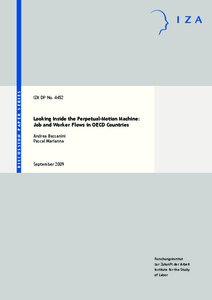Looking inside the perpetual-motion machine: job and worker flows in OECD countries
"There is an increasing interest in the process of job creation and destruction as well of hirings and separations. Many studies suggest that idiosyncratic firm-level characteristics shape both job and worker flows in a similar way in all countries. Others argue that cross-country differences i...
| Main Authors: | , |
|---|---|
| Institution: | ETUI-European Trade Union Institute |
| Format: | TEXT |
| Language: | English |
| Published: |
Bonn
2009
IZA |
| Subjects: | |
| Online Access: | https://www.labourline.org/KENTIKA-19187112124919053949-Looking-inside-the-perpetual-m.htm |
| Summary: | "There is an increasing interest in the process of job creation and destruction as well of hirings and separations. Many studies suggest that idiosyncratic firm-level characteristics shape both job and worker flows in a similar way in all countries. Others argue that cross-country differences in terms of gross job flows are minor. However, these statements are usually based on the comparison of national estimates, typically collected on the basis of different definitions and collection protocols. By contrast, in this paper, we use cross-country comparable data on both job and worker flows to examine key determinants of these flows and of their cross-country differences. We find that idiosyncratic firm (industry, firm age and size) and worker (age, gender, education) characteristics play an important role for both gross job and worker flows in all countries. Nevertheless, in contrast with part of the literature, we find that, even controlling for these factors, cross-country differences concerning both gross job and worker flows appear large and of a similar magnitude. Both job and worker flows in countries such as the United States and the United Kingdom exceed those in certain continental European countries by a factor of two. Moreover, the variation of worker flows across different dimensions is well explained by the variation of job flows, suggesting that, to a certain extent, the two flows can be used as substitutes in cross-country analysis. Consistently, churning flows, that is flows originating by firms churning workers and employees quitting and being replaced, display much less cross-country variation." |
|---|---|
| Physical Description: | 53 p. Digital |

